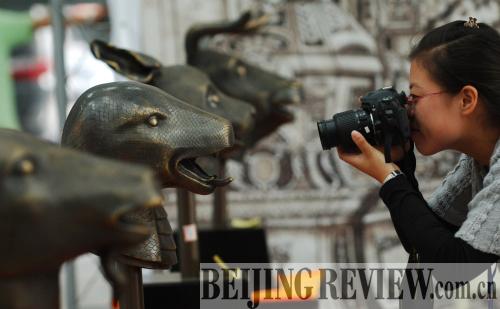|
 |
|
CHINESE ORIGIN: Two bronze animal heads from the Old Summer Palace went up for auction in Paris earlier this year, drawing protests from the Chinese people and the media (LI JIAN) |
At least 1.5 million artifacts were believed to have been shipped from the Old Summer Palace, or Yuanmingyuan, to the hands of museums and private collectors, both domestic and foreign, after the imperial garden was burned and looted in the 1860s during the Second Opium War.
The Yuanmingyuan Administrative Office launched an initiative to trace the palace's lost relics overseas on October 18, the 149th anniversary of the destruction of the imperial garden. A team of historians and experts on cultural relics protection from the office and Tsinghua University will visit more than 2,000 museums, libraries and private collections in the United States, Britain, France and Japan.
But the goal of the massive relic hunt is not repatriation of the items, but to identify and document relics looted from the palace, said Chen Mingjie, Director of the Yuanmingyuan Administrative Office.
"We have clarified that this is an attempt to document rather than seeking a return of those relics," he said. "We do hope some previously unknown relics might surface and some might be returned to our country during our tracing effort."
A complete catalog
The operation aims to create a complete catalog and visual record of artifacts that have made their way overseas since current data do not provide exact figures for how many were once kept in the palace. Former archives documenting architectural works, various furnishings, antique artworks and treasures were burned in the 1860 fire along with other priceless relics, according to Wang Daocheng, a scholar on the history of the Old Summer Palace and the Qing Dynasty at the Renmin University of China.
Despite the loss of original documentation, overseas museums for the most part have maintained accurate records of their collections, as the origin of historical pieces is indispensable to assessing the value of such relics. "If overseas museums and libraries assist us, we could work out a comparatively complete catalog of the palace's overall collection, how many of them have survived the fire, and where they are now," Wang said.
The aim also explains why the team will make its first stop in the United States, instead of Britain and France which are believed to have most of the palace's lost relics, according to Chen.
"For a complete catalog, we need to see the items, but we will be more reliant on historical documents, " Chen said. "The preparatory research work indicates that the United States has more related documents and photographs of the palace at different degrees of destruction than other countries."
The team will head for the United States next month, making stops at more than 10 institutions in Washington, D.C., New York and Boston, which have collections of more than 100 photographs that have never been released to the public.
After the U.S. trip, the team will travel to Europe, making stops in Britain and France, and then proceed to Asian countries, like Japan, next year. Through the research, the team looks to compile an improved database of cultural relics and materials for an exhibition in the second half of 2010. Meanwhile, a picture album of the palace's cultural relics that now reside in foreign countries will also be published.
Chen said that they will also strive to gain consent from the overseas museums and organizations to bring the artifacts back for exhibitions in China.
An uneasy journey
Statistics from the United Nations Educational, Scientific and Cultural Organization (UNESCO) show that more than 164 million Chinese artifacts are now retained in 47 museums across the globe. The British Museum ranks first with its substantial 230,000-piece collection of Old Summer Palace artifacts.
"We understand it is about archiving and documentation. We would be happy to have any discussion with anyone who comes forward," said British Museum spokeswoman Esme Wilson on October 20.
Even with promises of cooperation, it remains unclear whether the British Museum will grant Chinese researchers access to 90 percent of its collection that has remained behind closed doors since China would be entitled to reclaim these looted cultural artifacts under the 1970 UNESCO Convention on the Means of Prohibiting and Preventing the Illicit Import, Export and Transfer of Ownership of Cultural Property.
Chen, in an interview with The Beijing News, outlined a few difficulties in the retracing initiative. While certain obstacles are easy to overcome, like the requirement to pay for photography and consulting materials, others may prove to be more challenging. The trickiest part may be the lack of records for tracing items that have passed through the hands of numerous private collectors, Chen said.
Another challenge comes from the inability of researchers and historians alike to identify specific objects' origins from the Old Summer Palace or even the Forbidden City.
But in certain instances, relics are unquestionably recognizable, as was the case in the auctioning of two bronze animal heads from the Old Summer Palace in Paris earlier this year, Chen said.
The obstacles in the coming endeavor have not deterred the Chinese team as they make preparations and begin receiving data from abroad. The Duke University has already sent the office high-definition copies of seven photographs they have on file of the palace. These pictures, taken in 1918, record many Western-style constructions of stone carving that were already destroyed.
"Photographs of the palace around the 1920s have rarely been seen and will help restore the ruins and assist related research," Chen said. | 